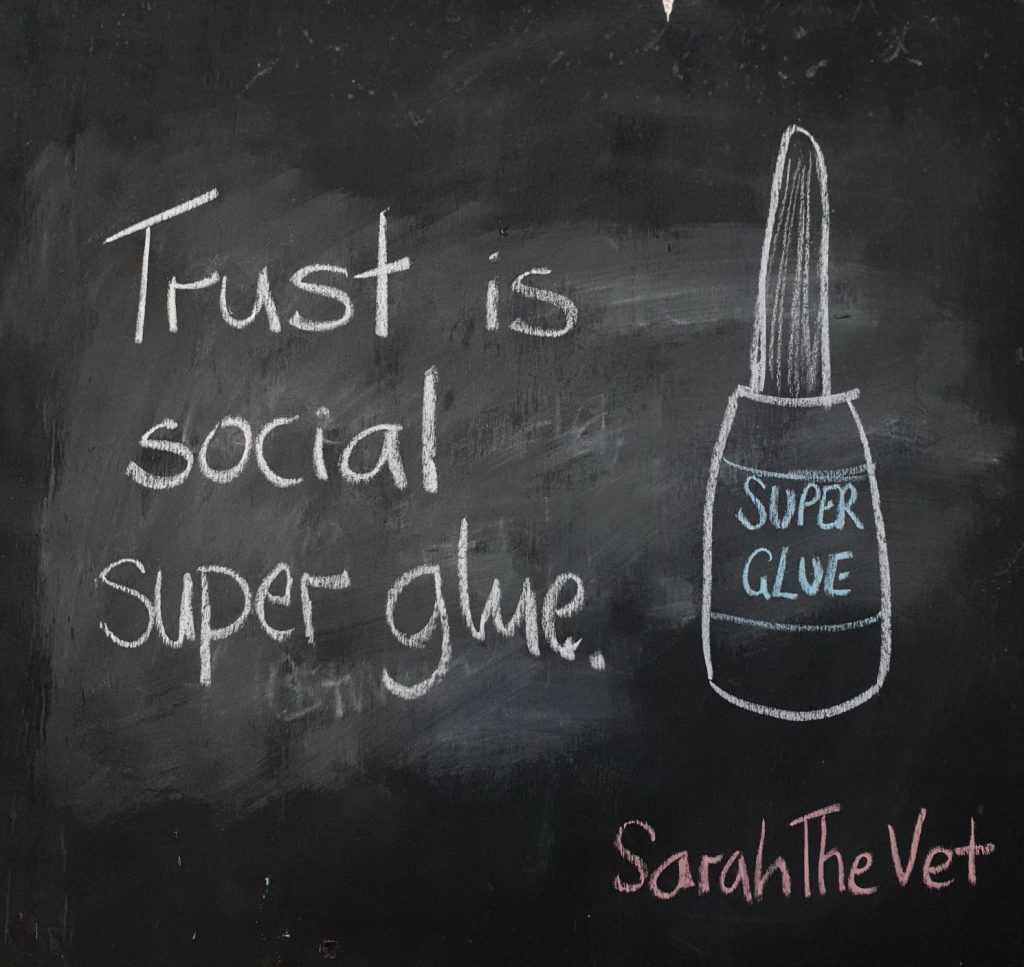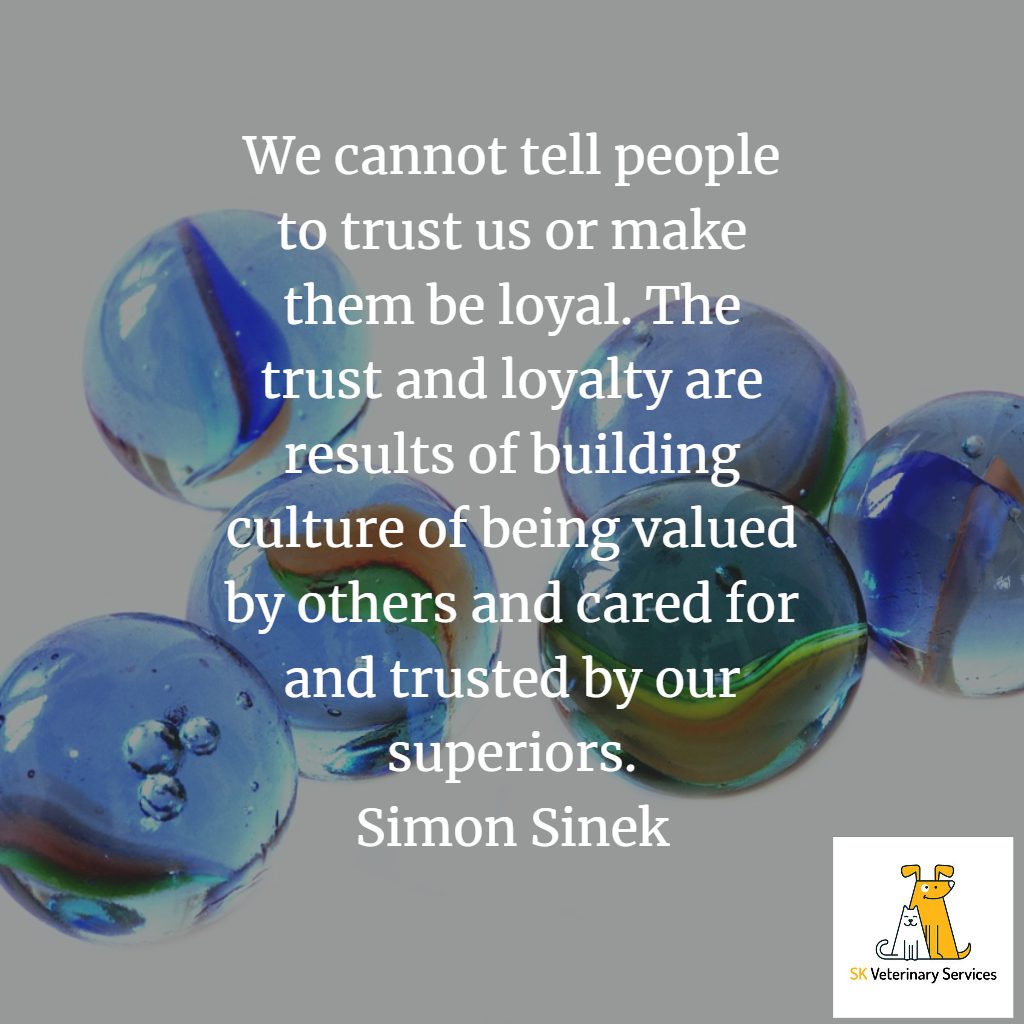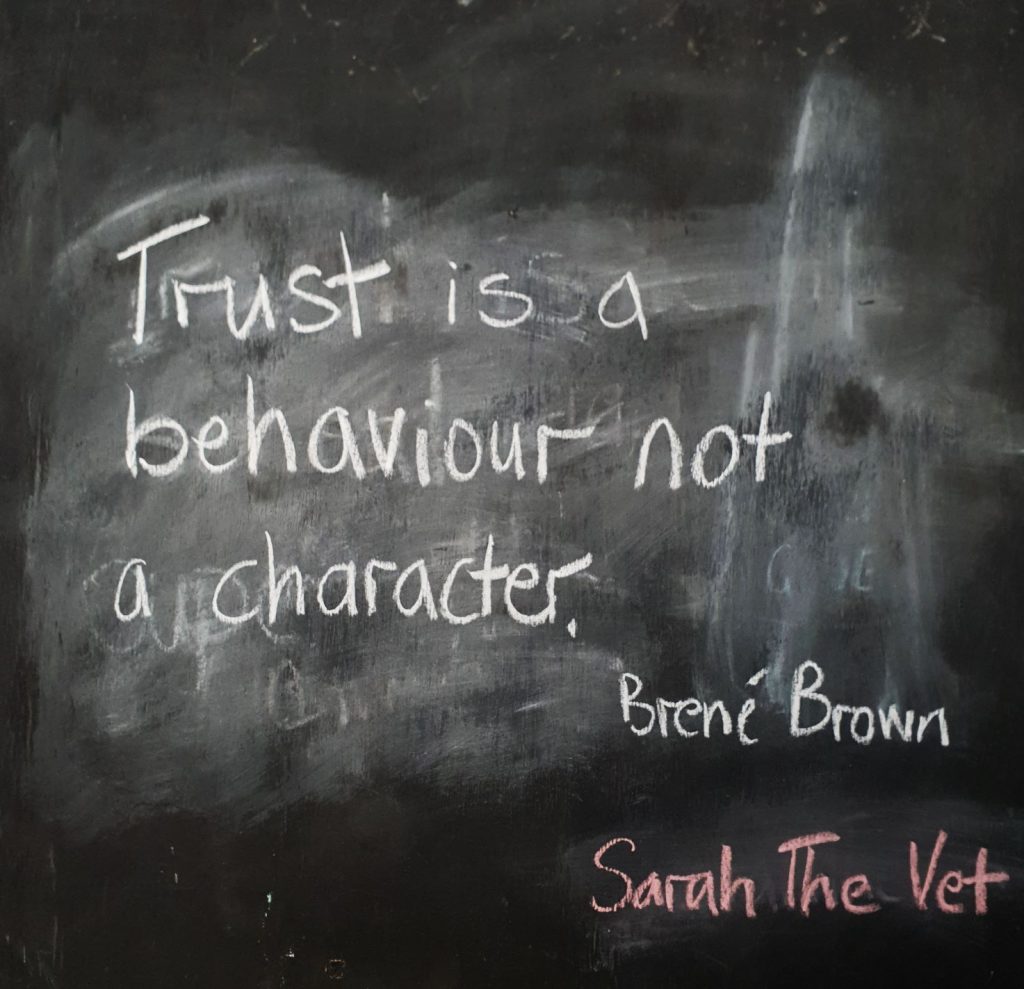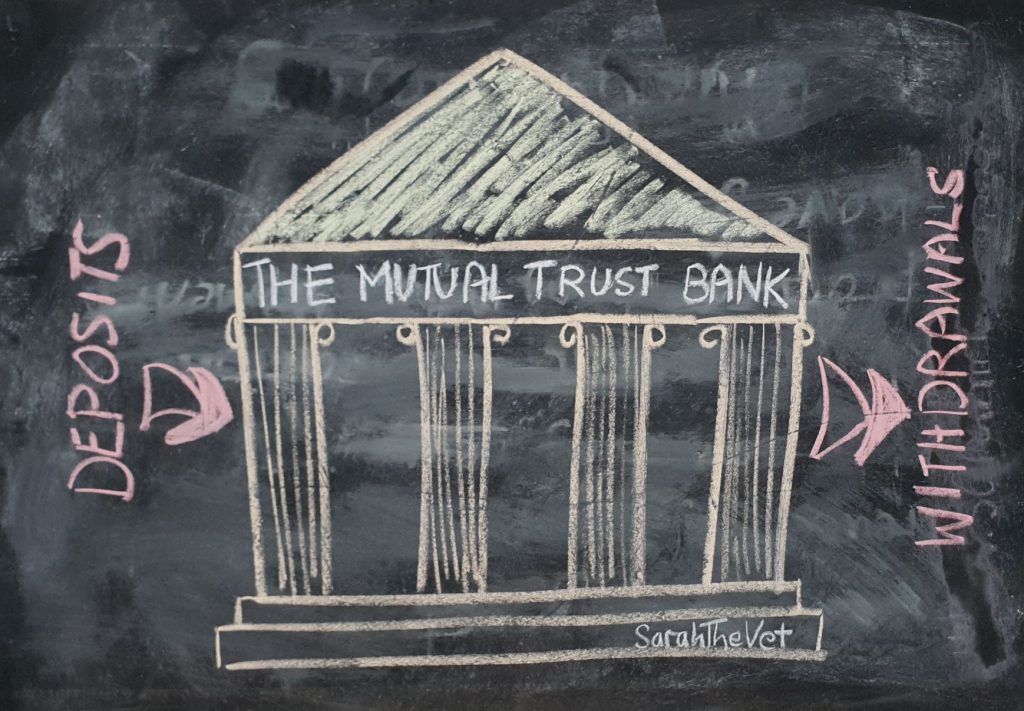I’m sure I’m not alone in having difficulty in describing what trust is – it is just too big, complex and vague. Trust is essential in healthy relationships, vital for connection in the social human species, in both workplaces and personal relationships. Yet, despite its essential nature in all types of relationships, trust is one of the key factors I’ve found lacking in a number of veterinary practices with negative ramifications such as defensive practices clinically and non-clinically (read more here), disengagement from the job, low cooperation in teams, suspicion and doubt causing anxiety and stress all the way to outright competition and fear. Unsurprisingly all lead to reduced outcomes personally and clinically, reduced productivity and retainment issues. Could improving the lack of trust in workplaces play a part in repairing the professions current issues?

Trust. So what is it?
I like Charles Feltman’s description of trust – trust is choosing to risk making something you value vulnerable to someone else’s actions. For this to happen there needs to be some safety in the relationship and this is what trust boils down to – it is the belief that someone will hold you in safety with what you share with them. It is not just a feeling or emotion; it is a cognitive assessment that has been shown to be rationalised through visible actions i.e. the behaviours that we see. Trust has a biological basis – it is formed when oxytocin is produced. However, high stress is an oxytocin inhibitor and veterinary practices are frequently high stress workplaces.
The best analogy for trust I have come across is described by Brené Brown as the marble jar; building trust is putting a marble in the jar for that relationship but when trust is broken then large handfuls of marbles are removed, or potentially even the jar is broken. Like a bank, for a relationship to have trust you need to make frequent deposits in order to make withdrawals and getting overdrawn is just not an option in this bank. No credit is given.
Generally, trust takes a long time to create, slowly, bit by bit; it is not yes or no, or on or off. Yet it can so easily be destroyed and very quickly, sometimes even without the person realising what they have done. Also, once trust is broken it is almost impossible to be remade as some form of betrayal has happened, a very deep and painful emotion. Some relationships start with an amount of assumed trust e.g. a new employee starting a job, but these are also the times that the trust is most fragile. Trust is the bedrock for leadership, teamwork and engaged people, but there is often little thought put into how it should be created and kept alive.
Regarding the veterinary profession, trust in working relationships is connected to psychological safety, an area that is gaining great ground in its application in many areas of medical care. Trust is the foundation for psychological safety, but they are not equivalent; trust is about personal relationships with individuals, psychological safety is group trust where team members feel safe to take risks and be vulnerable in front of each other.

The emotion of trust
Trust is not an emotion itself but when someone questions our trustworthiness we feel it emotionally and it sets up our vulnerability lockdown in motion – we put up shields, put on armour and defences are on high alert. When trust is missing in a relationship, we spend much more energy and time in the assessment of threats and survival mode. This emotional survival mode stems from our limbic system – the responses are reflexes – because connection and social is key to human survival. Trust is a feeling not an instruction; you cannot tell someone they can trust you (this is directly for my last boss). That’s up to them to decide through your behaviours, actions and language towards them.

Anti-trust = lack of trust
It is often harder to tell when trust is present than when it isn’t. We need to look for tangible, visible behaviours to assess its presence but often we don’t realise what we are seeing or experiencing is trust or some form of anti-trust. Some things can be quite obvious to see but some are much more subtle and we only see them for what they are by reflection or if they are pointed out to us by a third party. It is easier to see anti-trust than trust as it quickly leads to working in fear and shame, causing intense emotions that we feel as ‘gut-feelings’. These things are as true in personal relationships as professional ones. I believe anti-trust is the hallmark of a toxic culture; though there are many other causes of toxic cultures, I believe that the lack of trust is the most important by far.
There isn’t a direct word for the lack trust so I’m using anti-trust to describe when trust is absent – it covers mistrust, distrust, and betrayal, but can be much smaller and more subtle. What follows are some examples of anti-trust that I have seen and sometimes experienced in veterinary practices. I hope this list will be of use to raise awareness of identifying anti-trust in your personal and work relationships. This is useful if you need to assess a team that you might be working with (as employee, locum or coming in as a leader) but also by recognising anti-trust, you will be able to identify what will get in the way of building trust.

Anti-trust examples in the veterinary profession:
- Someone asking you ‘Do you not trust me?’ or saying ‘Trust me’. Or the business values on the wall include ‘trust’. Trust is something you earn in a relationship; it’s up to others to grant you trust.
- Not doing something they said they would do or saying they would never do something and then doing it – this is reliability. For example, your clinical director says they will get x sorted and despite you asking repeatedly for x as it is important for you and what you need, it doesn’t get sorted. This could be changing the rota or replacing a broken bit of kit or giving you time on the rota for the project they want you to complete. Or it could be the practice owner saying they would never sell the practice to a corporate, yet a few months later the announcement is made that the practice has been sold to a corporate.
- They have no boundaries and they don’t respect your boundaries. People that don’t like you having boundaries don’t like it because they are gaining something by you not having boundaries – they are getting something from the relationship that serves them but in no way serves you. For example, clearly stating that you would not work more than x hours a week and then finding out the rota is changed to be more than x without reasonable explanation or any explanation other than it is what it is and you have to accept it.
- Not being accountable for actions or mistakes. It is very unlikely that a person behaving like this is actually a bad person – it is much more likely they are acting from a place of fear, emotional pain or shame. Mistakes do and will happen. When there is no active listening and curiosity by leaders to get to the bottom of these events then they are often misrepresented as a character flaw rather than a reflection of the leadership of that person and the culture they create. This might show as people hiding mistakes or not wanting to take part in meetings like critical incident reviews.

- Blame shifting and credit stealing. Have you ever brought up a good idea such as fear free training for all the staff or organised and held say a bake-off, just to find that the practice boss takes the credit? Taking credit for someone else’s work or idea, or failing to acknowledge their role is demoralising and diminishing – eventually people will stop trying and become disengaged.
- Blaming individuals rather than investigating the whole when many problems turn out to have systemic causes. This is very common in poorly held clinical events investigations or meetings where there is a blame culture. The staff may be so fearful of the blame becoming personal that they refuse to take part in such meetings. Another example is only getting one side of the story before deciding what happened in reality or being curious as to why it appeared like that (read my post on perspective and stories for more on this).
- Gaslighting. This could be discrediting you or your feelings (“only you are finding the rota hard”); changing topic or not taking your concern seriously; trivialising your emotions and feelings (being told “you’re overreacting”, “it’s not that bad”, “you are so sensitive”, “pull yourself together”); rewriting history so you find yourself questioning your memory of events (are you getting to the stage of writing notes for everything they tell you and every meeting just so you can prove to yourself you’re not losing your mind?); you feel like you are ignored or dismissed (e.g. when you ask a question in a team meeting and the response is what you shared is not important, not valid or not needed (yep, I‘ve had this one a lot)); telling you things that just aren’t true (“you’re making all the staff cry”, when actually it was the manager making you cry). Gaslighting is a marker for manipulation and abuse and toxic environments. It may not be intentional or malicious, and even seems to be some part of old-fashioned management techniques. Worryingly, most people don’t realise they are doing it or it is happening to them until someone on the outside points out that the behaviour is gaslighting.
- Using shame or guilt to get people to do things. Have you ever been guilt tripped into doing something you didn’t want to do? For example, “I’m so disappointed you didn’t get x work done by y because now the practice can’t make money and it puts all the jobs here at risk”. Or shamed or humiliated, especially if publicly (social shaming) e.g. being late for a meeting for the first time in 6 months and being made to stand in front of the room and tell a joke. And you are an introvert. Just so wrong on so many levels.
- Staff not feeling safe e.g. if a complaint is made against them then worry the boss won’t have your back in protecting you from the complainant or the RCVS, or if you’ve seen management undermine a member of staff in front of other staff or even a member of the public.
- Using fear as a management tool. The opposite of trust is fear e.g. threating an action such as firing you unless you do as they say. This could also extend to excessive reading of employee’s clinical notes and pulling them up on minor things, creating fear in the minds of the employees even if it is only the perception of fear. The most obvious outward expression of this fear is defensive medicine (see my article).
- Micromanagement by leaders. Not trusting employees to do a task and a lack of autonomy in how they do the work. Leaders not delegating is telling the team that they don’t trust them. Similarly, if employees don’t trust their employers they work for their own benefit and protect their own interests (Simon Sinek writes and speaks wonderfully on this).
- Monitoring performance over people. Ever had a boss that reads your clinical notes, perhaps for all your cases, and then pulls you up for every little thing? The workplace where it feels like they are trying to catch you out when you do something wrong rather than concentrating on building systems and environment when you can get things right. Also covers the remote monitoring of performance.
- Unable to give feedback in an honest, constructive way or avoid giving it at all or using shame as part of the feedback. If you withhold feedback because you’re worried about the other persons response, it’s a sign you haven’t earnt their trust. Does the person giving feedback use it a weapon, do they bring shame and blame to the feedback, do they deny their role in the issue, do they try and sandwich it with some positive feedback?
- Not having open conversations. If there is a lack of open and difficult conversations, this is a strong indicator that the person or team is not trusting this relationship enough to share – perhaps scared that the other person will not keep their confidence secret and unshared or shame and humiliation will be the result. The consequence of the lack of open conversations are:
- Not asking for help, or to say their life outside work is affecting their work.
- Scared to bring up issues as the other person becomes defensive.
- Are you disregarded or made to feel it is a non-issue or you’re the issue.
- As a leader, do they always say I’m fine/OK when you ask? The same is true for leaders who pretend everything is alright in the business when it clearly isn’t.
- Perhaps no-one is willing to voice ideas and opinions in meetings, instead sitting there dumb or agreeing with anything and everything.
- Not speaking up when witnessing something wrong, especially if ethically or morally wrong. For example, witnessing the head nurse pinning a dog to the ground by sitting on it in order that it can have its nails clipped.
- Gossiping and rumours abound in the team and the leaders don’t realise or step in to sort it. Gossiping and rumours are often based in judgement and shame talk and can exclude people from groups and cause cliques. This can appear as talking about people rather than instead of to them. Banter can often be excluding, and it can be difficult to speak up against it.
- People are not willing to ask for help. Not feeling that the person cares through a lack of empathy and sympathy or people unwilling to be vulnerable in relationships such as asking for help, where it could be seen as a weakness and weaponised.
- Non-present leaders. They are physically not on site or only rarely, or are in a distant part of the building yet say ‘come find me if you need me, my door is always open’ or ‘just phone or message me if you need me.’ Or are busy in clinical work all day every day rather than being a present leader.
- Leaders not sharing their company’s goals, strategies, and vision. This uncertainty about the company’s direction leads to chronic stress and mistrust.
- Unfair and discriminating treatment, even if the perception of it rather than a reality. This comes from a lack of transparency which is a function of a lack of sharing of information. A key example in the profession is the lack of transparency over salaries and how they are calculated. Clauses in contracts that forbid employees from discussing salaries doesn’t help the situation as it creates secrecy and mistrust, despite these clauses actually being illegal. Unfair treatment can also come from the lack of transparency over promotions such as it appears that the people that are promoted are the ones kiss ass best.
Conclusion
Sadly, a good number of these points seem to be the way veterinary management is/was taught and are widespread in the profession. However, workplaces ignore trust issues at the expense of performance and success of their employees and hence their business. If there is no trust then there is no connection and that is bad for work that is a team game like veterinary care.
What have you seen or experienced in regard to anti-trust? Do any of these ring true for you? It was a whole lot easier for me to write this first part than the next part on building trust as sadly it is all too common to see and experience anti-trust in the veterinary profession; part 2 will look at how to build trust.


Leave a Reply